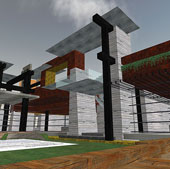
The L.A. Times ran an interesting story this week, 'Virtual marketers have second thoughts about Second Life'. The article covers the issues Second Life is experiencing when it comes to maintaining the initial flurry of 'virtual' commercial participation within the online world. This news is troubling because it was this same commercial interest that led many to declare Second Life to be the 'next big thing' which would one day surpass the 2-dimensional World Wide Web. Unfortunately such claims seem to have been all but put to rest with the rise of competing virtual worlds and slowing economic and social growth in Second Life.
News that commercial marketing interest is waning comes as no surprise when one takes into account the actual number of Second Life users active at one time.
Even at peak times, only about 30,000 to 40,000 users are logged on, said Brian Haven, an analyst with Forrester Research.
This low active user count just does not provide the marketing economies of scale available when compared to the traditional Web. Once this low population is distributed across a relatively large virtual environment and the cost of participation is factored in (land and development time) involvement by a commercial entity becomes difficult to economically justify. As Duncan Rilely of TechCrunch describes:
If we apportion the upfront costs of design (say $5,000 although it’s probably higher) and setup ($1675) over 12 months the CPM rates become $21.20 (top) and approx $180 (bottom of the top 5). The CTR rate is irrelevant: the CPM cost for businesses on Second Life is insane: simply even for the very best, the figures don’t add up.
Note: CPM is marketing speak for Cost per thousand impressions whilst CTR is an acronym for Click-through Rate.

